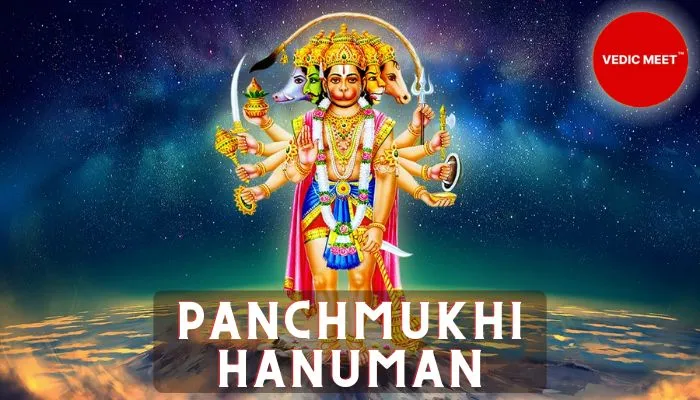Panchmukhi Hanuman: Exploring the Five Faces of Divine Devotion

In the vast tapestry of Hindu mythology, few characters resonate as deeply as Panchmukhi Hanuman. This revered deity, with his five distinct faces symbolizing various aspects of strength, wisdom, and devotion, holds a special place in the hearts of millions worldwide. Let's embark on a journey to uncover the mysteries and marvels surrounding Panchmukhi Hanuman.
Origin and Mythology
The origins of Panchmukhi Hanuman trace back to a pivotal moment in the Ramayana, the epic saga of Lord Rama's divine journey. Legend has it that during the fierce battle between Lord Rama's army and the demon king Ravana's forces, Lakshmana, Rama's loyal brother, lay gravely injured. To save Lakshmana's life, Hanuman embarked on a mission to bring the life-saving Sanjeevani herb from the Himalayas.
It was during this critical quest that Hanuman revealed his five faces, each representing a different deity and divine aspect. His original face, that of a Vanara, symbolized humility and service. The Narasimha face, resembling a fierce lion, embodied courage and fearlessness. The Garuda face, akin to a majestic eagle, signified swiftness and protection. The Varaha face, reminiscent of a powerful boar, represented strength and resilience. Lastly, the Hayagriva face, resembling a wise horse, epitomized knowledge and wisdom.
Symbolism and Interpretations
The symbolism of Panchmukhi Hanuman runs deep, resonating with devotees on multiple levels. Each face represents not just a physical form but a spiritual attribute that devotees aspire to cultivate. The humility of the Vanara face reminds us of the importance of service and selflessness in our lives. The Narasimha face instills the courage to face adversity head-on without fear or hesitation.
Garuda's swift and protective nature inspires us to be vigilant and protective of our loved ones. Varaha's strength and resilience teach us to withstand life's challenges with fortitude. The Hayagriva face, with its wisdom and knowledge, encourages lifelong learning and introspection.
Iconography and Depictions
In art and sculpture, Panchmukhi Hanuman is depicted in various forms, each capturing the essence of his multifaceted nature. Traditional depictions often show him with five distinct faces, each radiating divine energy and purpose. The intricate details in these representations showcase the rich symbolism associated with Hanuman's five forms.
Worship and Festivals
Devotion to Panchmukhi Hanuman is genuine and widespread. Numerous temples across India and beyond are dedicated to him, attracting devotees seeking blessings for courage, protection, knowledge, and overall well-being. Festivals such as Hanuman Jayanti, commemorating Hanuman's birth, are celebrated with great zeal, with devotees reciting Hanuman Chalisa and other prayers to honor his divine presence.
Mantras and Prayers
Chanting Hanuman mantras and prayers holds a special place in Hindu spiritual practices. The Hanuman Chalisa, a 40-verse hymn dedicated to Hanuman's praise, is widely revered for its potency in invoking Hanuman's blessings and divine intervention. Devotees often recite these mantras with utmost devotion, seeking strength, courage, and spiritual enlightenment.
Role in Hindu Mythology
Panchmukhi Hanuman's role in Hindu mythology extends beyond the Ramayana. He is revered as a symbol of loyalty, devotion, and unwavering commitment to righteousness. His selfless acts and unwavering loyalty to Lord Rama make him a beloved figure whose teachings continue to inspire generations.
Cultural Influence
The cultural influence of Panchmukhi Hanuman is profound, permeating literature, art, music, and spiritual discourse. Folklore and legends surrounding Hanuman's exploits are passed down through generations, enriching the cultural heritage of devotees worldwide.
Read our blogs: Mohini avatar of Vishnu
Contemporary Relevance
In modern times, devotion to Panchmukhi Hanuman remains steadfast. His teachings on courage, humility, and devotion are timeless, offering solace and guidance to individuals navigating life's challenges.
Scientific and Philosophical Perspectives
From a philosophical standpoint, Panchmukhi Hanuman's five faces can be interpreted as facets of human consciousness. Each face represents a dimension of our inner selves, urging us to integrate strength, courage, wisdom, and humility into our daily lives.
Global Recognition
Beyond India, Panchmukhi Hanuman's devotion has crossed cultural boundaries, resonating with people of diverse backgrounds who seek spiritual growth and enlightenment.
Panchmukhi Hanuman in Yoga and Meditation
Yogic and meditative practices often draw inspiration from Hanuman's qualities. The Hanumanasana (Monkey Pose) in yoga is named after him, symbolizing flexibility, strength, and balance. Meditations on Hanuman's virtues help practitioners cultivate inner strength, focus, and clarity of mind.
Conclusion
In conclusion, Panchmukhi Hanuman stands as a timeless symbol of devotion, courage, and divine grace. His multifaceted nature and profound teachings continue to inspire millions on their spiritual journey, reminding us of the boundless potential within each of us to embody strength, wisdom, and unwavering faith.
- Art
- Causes
- Crafts
- Dance
- Drinks
- Film
- Fitness
- Food
- Spiele
- Gardening
- Health
- Startseite
- Literature
- Music
- Networking
- Andere
- Party
- Religion
- Shopping
- Sports
- Theater
- Wellness
- IT, Cloud, Software and Technology


